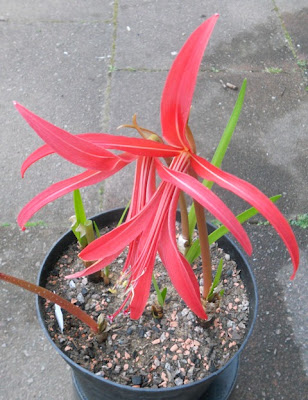I like common names (and the Aztec Lily)
And scientific names (and Sprekelia formosissima var. karwinskii).
Common names are often pooh-poohed by the scientists who name plants, taxonomists. And with good reason. A Blue Gum can refer to different species of eucalypt depending where on Australia you live, and calling the Australian tree Grevillea robusta a Silky Oak misleads us into thinking it might be a close relative of the English Oak, Quercus robur, which it isn't.
That said, when I was writing about Glory of the Snow a few blogs back, it was easier to search for the common name rather than the scientific name due to the changing taxonomic fortunes of this species of Chionodoxa.
Today's botanical subject, Sprekelia formosissima var. karwinskii, has a difficult to remember scientific name and one that doesn't add much to my understanding of the plant. Sprekelia is named after the lawyer Johann Heinrich von Spreckelsen, a friend of Carl Linnaeus who described this genus in the late 18th century. So that doesn't help a lot.
The species name formosissima didn't add much either, at first. Formosa is the earlier name for Taiwan and it doesn't come from there; '-issima' usually means stronger or more so. So I was at a loss with the species name until Jim Croft (not a Latin scholar, as he self confesses, but certainly a web information gathering scholar) pointed me to the following definition. 'Beautiful', and very much so. Perfectissimo, although not really telling me more about the plant.
As for the variety name, Wilhelm Friedrich Karwinsky von Karwin was a Hungarian plant collector who spent some time in Mexico in the early 19th century. At least now we are getting warm: all three species of Sprekelia come from Central America, and particularly Mexico.
The first common name I encountered for this plant was Aztec Lily. Immediately I was transported to Mexico! That said, I might have been mislead into thinking it was a Lilium or in the family Liliaceae. It ain't, it's Sprekelia in the family Amaryllidaceae. Not light years away from the lilies in Liliaceae but certainly different.
The next name was Jacobean Lily. Let's leave the lily part - lots of common names use this helpful if taxonomically imprecise tag - but the Jacobean bit has me stumped. The Jacobean age or period was at the start of the 17th century, which doesn't seem to relate to this plant in any way. Maybe its a biblical reference? Again one for other scholars.
And the third common name commonly used? St James Lily. Well, back to the bible and no joy for me.
So not all the common names helped but I like Aztec Lily for this plant. The vivid red flowers almost shimmer in the sun, bringing to mind Aztec treasures as well as Mexico. That's a perfect common name. It's informative and evocative.
I have to finish with a confession though. I've sung the praise of a common name that seem to apply to the species as a whole (not just Karwinski's variety) and possibly the whole genus. For more precision, well, use a scientific name if you must.
Images: A pot of Aztec Lily from Kew's Tropical Nursery spending a week with us in our Kew Gardens home. Each week we are trialling a different plant to see how well it survives in a domestic setting.



Comments
And thanks Jim! I've altered the relevant paragraph to: "The species name formosissima didn't add much either, at first. Formosa is the earlier name for Taiwan and it doesn't come from there; '-issima' usually means stronger or more so. So I was at a loss with the species name until Jim Croft (not a Latin scholar, as he self confesses, but certainly a web information gathering scholar) pointed me to the following definition. 'Beautiful', and very much so. Perfectissimo, although not really telling me more about the plant."